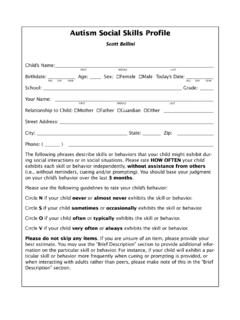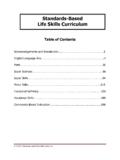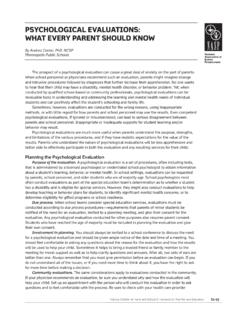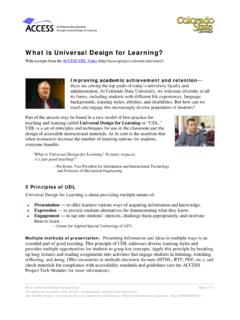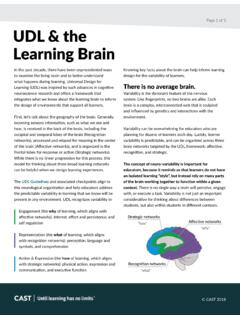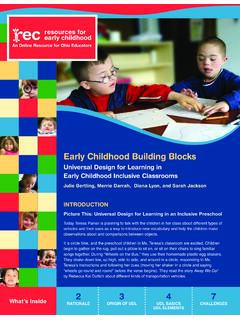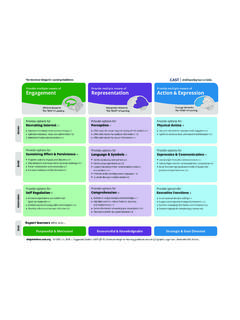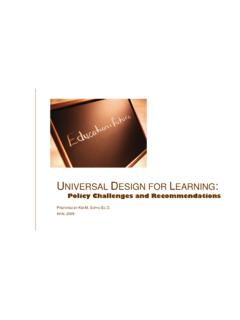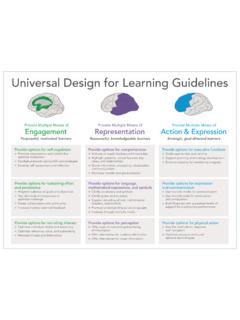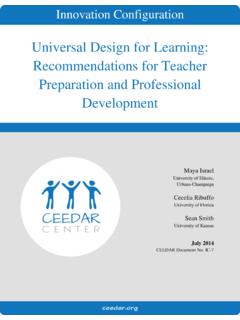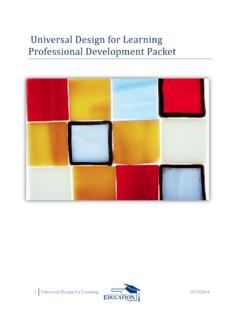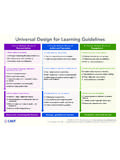Transcription of Universal Design for Learning Special Education - …
1 Special Education Technology Practice 16 November/December 2005 The origin of the term Universal Design for Learning (UDL) is generally attributed to David Rose, Anne Meyer, and colleagues at the Center for Applied Special Technology (CAST). The prin-ciples of UDL were developed following the 1997 reauthorization of the Individuals with Disabilities Education Act (IDEA). At that time there was con-siderable national interest in the issue of inclusion which placed the majority of students with dis-abilities in general Education classrooms. While students with disabilities had gained physical access to the general Education classroom, concerns were being raised about how students would gain access to the general curriculum. McLaughlin (1999) reported that IDEA reau-thorization contained several specific mandates relative to making the general curriculum acces-sible for students with disabilities: Statements of a child s present level of educa-tional performance to specify how his or her disability affects involvement and progress in the general Design for LearningBy Dave L.
2 Edyburn IEP teams to Design measurable annual goals, including short-term objectives or new bench-marks, to enable the child to be involved-and progress-in the general curriculum. A statement of the Special Education and related services and supplementary aids and services to be provided to the child. A description of any program modifications or supports for school personnel necessary for the child to advance appropriately toward the annu-al goals, to progress in the general curriculum, and to be educated and participate with other children both with and without disabilities. IEP team members to document an explanation of the extent, if any, to which the child will not participate with children without disabilities in the general class and interested in a legal analysis of the issues associated with access to the curriculum are encouraged to review Karger and Hitchcock (2004). The issues associated with access to the curriculum were at the forefront of CAST s work and in 1999 they were awarded a federal grant to establish the National Center on Accessing the General Cur-riculum that became instrumental in garnering national attention for the potential of is UDL?
3 Rose and Meyer (2002) reveal the basis of UDL is grounded in emerging insights about brain development, Learning , and digital media. They observed the disconnect between an increasingly diverse student population and a one-size-fits-all curriculum would not produce the academic achievement gains that were being sought. Draw-ing on the historical application of Universal Design in architectural ( , curb cuts), CAST advanced the concept of Universal Design for Learning as a means of focusing research, development, and edu-cational practice on understanding diversity and applying technology to facilitate : Edyburn, (2005). Universal Design for Learning . Special Education Technology Practice, 7(5), 16-22. Reprinted with Education Technology Practice 17 November/December 2005 CAST s philosophy of UDL is embodied in a series of principles that serve as the core compo-nents of UDL: Multiple means of representation to give learn-ers various ways of acquiring information and knowledge Multiple means of expression to provide learners alternatives for demonstrating what they know, and Multiple means of engagement to tap into learn-ers interests, challenge them appropriately, and motivate them to the 2004 reauthorization of IDEA, the term Universal Design was officially defined within the federal law (20 1401) governing Special Education :The term Universal Design has the meaning given the term in section 3 of the Assistive Technology Act of 1998 ( 3002).
4 Following the backward chain of legal refer-ence, here is the definition of Universal Design as it was included in the Assistive Technology Act of 1998: Universal Design The term Universal Design means a concept or philosophy for designing and delivering products and services that are usable by people with the widest possible range of functional ca-pabilities, which include products and services that are directly usable (without requiring as-sistive technologies) and products and services that are made usable with assistive technolo-gies. ( 3002)Core Readings in Universal Design for LearningRose, D., & Meyer, A. (2002). Teaching every stu-dent in the digital age. Alexandria, VA: ASCD. Available online at: , , Meyer, A., & Hitchcock, C. (Eds.). (2005). The universally designed classroom: Accessible curriculum and digital technologies. Cambridge, MA: Harvard University Press. Recognizing the Value of UDLUDL has captured the imagination of policy makers, researchers, administrators, and teachers.
5 While initially focused as a strategy for providing access to the curriculum for students with disabili-ties, it has simultaneous benefits to many other students. UDL provides a vision for breaking the Special Education Technology Practice 18 November/December 2005 one-size-fits-all mold and therefore expands the opportunities for Learning for all students with Learning differences. Recognizing and responding to diversity is a core motivation for engaging in UDL practices. Finally, the expectations associated with No Child Left Behind (NCLB) makes UDL an important and timely strategy for enhancing student academic achievement. The mantra that evolved from our understanding of the value of curb cuts: Good Design for people with disabilities benefits everyone, provides a powerful rationale for exploring the large-scale application of UDL in ConnectionsDespite the many attributes of UDL, one down-side has been noted. That is, what is the relationship between UDL and assistive technology (AT)?
6 Some educators mistakenly assume UDL will replace AT since all needs will be anticipated and addressed. Rose, Hasselbring, Stahl, and Zabala (2005) address these concerns by noting that as-sistive technology and UDL can be thought of as two interventions on a continuum that involves reducing barriers (see Figure 1). At one end of the continuum, UDL seeks to reduce barriers for every-one. At the other end of the continuum, AT is used to reduce barriers for individuals with disabilities. However, in the middle, the interactions of the two interventions merge in a way that prevents clear demarcation of where one ends and the other access doesn t just happen. Sch-wan-ke, Smith, and Edyburn (2001) have argued that access for individuals with disabilities to facilities, programs, and information is a developmental process. The A3 model illustrates an ebb and flow of efforts that are needed to obtain Universal acces-sibility (see Figure 2). In the first phase, Advocacy efforts raise aware-ness of inequity and highlight the need for system change to respond to the needs of individuals with disabilities.
7 Accommodations are the typical response to advocacy. Therefore, inaccessible en-vironments and materials are modified and made available in phase two. Typically, accommodations are provided upon request. While this represents a Figure 2 The A3 Model illustrates the developmental phases of 1. The relationship between assistive technology and Universal Design for Education Technology Practice 19 November/December 2005significant improvement over situations found in the earlier phase, accommodations tend to main-tain inequity since there may be a delay ( , time to convert a handout from print to Braille), it may require Special effort to obtain ( , call ahead to schedule), or it may require going to a Special loca-tion ( , the only computer with screen reading software is in the library). In phase three, Acces-sibility describes an environment where access is equitably provided to everyone at the same time. The proportions illustrated in the graphic reveal the efforts associated with each of the three phases at any point in time relative to the impact of the general strategy being applied (advocacy that argues for need, accommodation to remediate inaccessibility, and accessibility where Universal access is provided for all).
8 Thus, the model offers a descriptive audit tool for organizations to self-assess their developmental phase relative to how they are spending their time and energy. While the model illustrates the optimal value of Universal Design and accessibility, it also suggests the devel-opmental reality associated with the need to make accommodations and modifications when UDL environments are not readily in PracticeAfter a person has embraced the principles of UDL, there is an urgent feeling to impact daily educational practice. This raises an interesting question: Is UDL a philosophy or an intervention? Actually, it is both. In this section we examine two strategies for operationalizing the principles of Access by DesignCAST has developed a number of products in which they have sought to operationalize their concepts of UDL. One such product is Thinking Reader (Scholastic) (see Figure 3). Thinking Reader is a software product that contains electronic books with supports for readers of all skill levels.
9 Specifi-cally designed for Grades 5-8, the Thinking Reader series presents unabridged, grade-level literature ( , A Wrinkle in Time; Roll of Thunder, Hear My Cry; Tuck Everlasting) that engage students in read-ing and interpreting a variety of literary works as they build understanding and begin, students log into the program, click the play button and the software reads the book while the text is highlighted on the screen. Key vocabulary words are underlined indicating a hy-perlink; students can click on the word to access a spoken and printed definition of the word. Spanish translations are also strategic points, a message appears indicat-ing: This is a good place to stop and think about the story. Students click on the message and they are linked to directions and questions that engage them in responding to what was just read. Seven research-based effective reading strategies are built into the software: summarize, question, clarify, predict, visualize, feeling, and reflect (see Figure 4).
10 Students answer different types and levels of questions such as open-ended, literal, and interpre-tative as well as test-like questions such as multiple choice and short levels of embedded reading comprehen-sion support are built into the program. Level 1 readers have the most supports and Level 5 has the least; levels can be adjusted as each student s com-prehension skills improve. The program features extensive student performance monitoring and reporting tools that allow teachers to view, print, or export reports (see Figure 5). Thinking Reader serves as a powerful example of the application of UDL principles and the notion of considerate text as a means of supporting all Access Through Accommo-Figure 3A screen print from Thinking Reader that provides extensive supports for readers of all skill levels as they interact with award-winning core Education Technology Practice 20 November/December 2005dations and ModificationsWhen UDL products and environments are not readily available, the principles of UDL can be applied to instructional materials and Learning environments in the context of accommodations and modifications.
